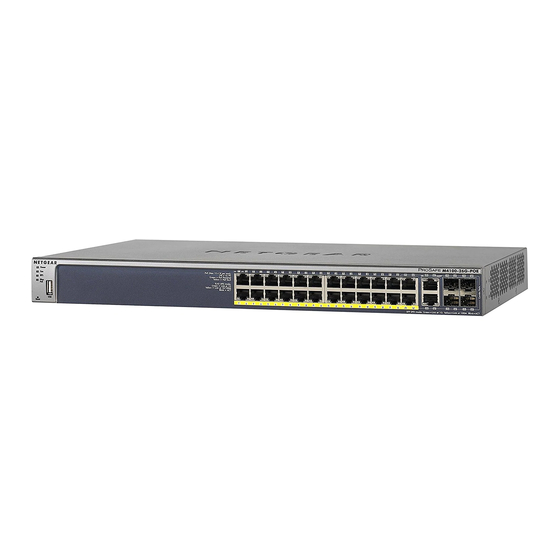
NETGEAR ProSafe M4100 Installation Manual
Connect with innovation.
managed switches
Hide thumbs
Also See for ProSafe M4100:
- Reference manual (578 pages) ,
- User manual (446 pages) ,
- Hardware installation manual (34 pages)
Advertisement
Quick Links
M4100_IG 7Nov2012.fm Page 1 Friday, November 9, 2012 3:34 PM
ProSafe M4100 Managed Switches
Start Here
Before you begin installation of your switch, check the package contents listed in
the hardware installation guide on the resource CD that came with your switch. If
any item is missing or damaged, contact your place of purchase.
The resource CD for your switch also includes the software administration guide
and a command-line interface reference manual.
Set Up the Switch
Prepare the site so that the mounting, access, power source, and environmental
requirements are met. If you have any questions about these requirements, see the
hardware installation guide for your switch on the resource CD.
1.
Install the switch using one of the following methods:
•
On a flat surface. Put one of the rubber footpads that came with the switch
on each of the four concave spaces on the bottom of the switch.
•
In a rack. Use the rack-mount kit supplied with your switch, following the
installation instructions in the hardware installation guide.
2.
Apply AC power.
When you apply power, the Power LED blinks yellow as it conducts a power-on
self-test (POST). After the switch passes the POST, the LED turns green. The
switch is now functional.
If the POST fails, the Power LED remains yellow (see "Troubleshooting" in the
hardware installation guide for assistance).
If the Power LED does not light, check that the power cable is plugged in
correctly and that the power source is good. If this action does not resolve the
Installation Guide
problem, see "Troubleshooting" in the hardware installation guide.
3.
Connect devices to the switch.
•
Use Category 5e (Cat5e) for copper ports at 1000 Mbps.
•
Use NETGEAR AGM731F or AGM732F for fiber ports at 1000 Mbps.
•
Use NETGEAR AFM735 for fiber ports at 100 Mbps.
Note:
Fiber SFP modules are shipped separately. For more information about
installing an SFP module, see the hardware installation guide.
Perform the Initial Configuration
You can manage this switch through its web interface, or by using the command-line
interface (CLI) through a console port. This guide describes the web method. The
CLI method is also described to determine a DHCP-assigned IP address or to use
ezconfig to assign a static IP address. For web management, follow one of the
following procedures, depending upon how your computer is set up.
•
Computer in DHCP client mode without DHCP server
•
Computer with static IP address
•
Computer in DHCP client mode with DHCP server
Computer in DHCP Client Mode without DHCP Server
WARNING!!
If no DHCP server is present, the switch assumes a default IP
address of 169.254.100.100 and a subnet mask of 255.255.0.0. The
switch must be in the same subnet used by the computer when in
DHCP-client mode without a DHCP server present. Log in to the
switch using this IP address (see
Web").
Computer with Static IP Address
When the computer is in this mode, the switch also needs to be assigned a static IP
address. To assign a static IP address, connect a VT100/ANSI terminal or a
workstation to one of the switch's console ports. A cable for the mini USB port is
supplied.
1.
Start a terminal emulation program (TEP):
•
Windows XP or earlier. Use HyperTerminal.
•
Windows Vista or later. Use a TEP from the Internet.
•
Macintosh. Use ZTerm.
•
UNIX. Use a terminal emulator such as TIP.
2.
Select a console port using the console switch on the rear panel:
•
Mini USB port (cable included).
Note:
You might need to install the USB serial port driver available on the
resource CD before you can use the USB port on the computer to connect to
the switch.
•
DB9 (cable not included).
3.
Configure the TEP with the following settings (written below the connector on
the switch front panel):
•
Baud rate. 115200 bps
•
Data bits. 8
•
Parity. none
•
Stop bit. 1
•
Flow control. none
4.
At the user prompt, log in to the switch using the user name
Enter.
"Log in to the Switch from the
5.
At the password prompt, press Enter again (no password is needed for initial
configuration).
6.
At the next command prompt, type
The ezconfig utility is now running in the switch.
7.
Set a static IP address and subnet mask using the ezconfig utility as shown in
the following example.
Make sure that the switch IP address is in the same subnet as the computer.
admin
and press
ezconfig
and press Enter.
Advertisement

Summary of Contents for NETGEAR ProSafe M4100
-
Page 1: Start Here
Use Category 5e (Cat5e) for copper ports at 1000 Mbps. supplied. ProSafe M4100 Managed Switches • Use NETGEAR AGM731F or AGM732F for fiber ports at 1000 Mbps. Start a terminal emulation program (TEP): • Use NETGEAR AFM735 for fiber ports at 100 Mbps. -
Page 2: Technical Support
Statement of Conditions: In the interest of improving internal design, operational function, and/or reliability, NETGEAR reserves the right to make changes to the products described in this document without notice. NETGEAR does not assume any liability that may occur due to the use or application of the product(s) or circuit...








